The aim of the TrAM project is to develop a new class of zero-emission fast going passenger ferries through advanced modular production. New manufacturing methods will contribute to lower production and engineering costs and make electric-powered high-speed vessels competitive. The project will build the world's first zero-emission, electric-powered, high-speed passenger ferry.
In the project, Fraunhofer IEM is responsible for developing a holistic methodology that supports the maritime industry in the design and construction of modular ferries. The project team is drawing on its extensive expertise in the field of model-based systems engineering to create a shared understanding of the system between all of the development partners. A system model is jointly developed that maps the requirements and effects of different use cases. While an individual system model is normally developed for each ferry and used as the basis for construction, the project brings together, relates and analyzes the requirements of different types of ferries. This allows interrelationships to be recognized and standard elements to be identified. Such a system model is solution-independent and can be flexibly used, which significantly reduces development time and manufacturing costs.
 Fraunhofer Institute for Mechatronic Systems Design
Fraunhofer Institute for Mechatronic Systems Design 
